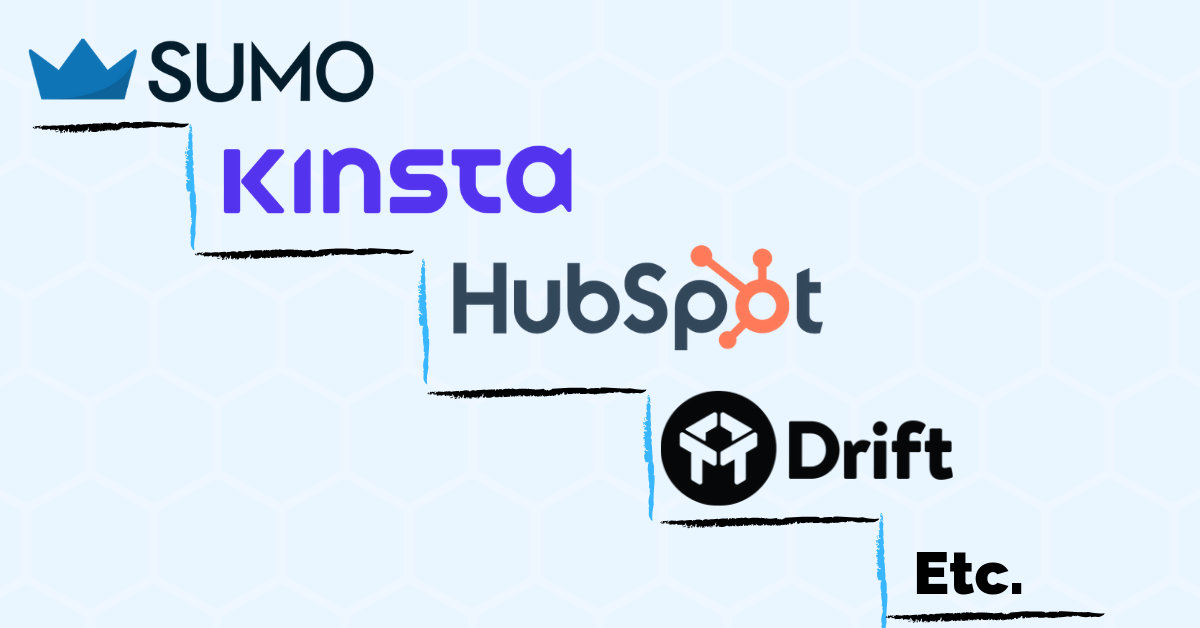
Some eight-ish years ago, you didn’t know what Drift was. (I have no affiliation with them, btw).
I didn’t either. Virtually nobody knew who they were.
But long story short, they’re now a SaaS brand that startups and enterprise companies look up to.
Drift’s content is one of the results you’ll see on SERP 1 when you search anything today relating to conversational marketing on Google.
They even got a featured snippet for the keyphrase.

And it’s the same for many other SaaS companies you know today — from HubSpot to Buffer, Buzzsumo to Zapier, and many more.
They rank for powerful keywords driving thousands of relevant monthly traffic and sign-ups.
So, whether or not to invest in SaaS content marketing is no longer the right question to ask.
“How do you use content to scale your SaaS business?”
That’s what you need to be asking now.
For answers, I asked some SaaS marketers and founders the following question:
“Do you know any SaaS brand seriously crushing their content marketing?”

Altogether, members of the groups I asked listed twenty-nine SaaS companies.
I picked eighteen that were doing really well. And I’ll be sharing them here, including how they’re crushing their SaaS content marketing what you can learn from them.
But before we dive into our best SaaS content marketing examples…
What’s a good SaaS content marketing strategy?
A good SaaS content marketing strategy is one that helps you achieve your goal(s), period.
This means there’s no one size fits all strategy — because goals aren’t the same for all SaaS companies.
For instance, Moz’s primary content goal might be to dominate the SEO industry with high-quality content ranking on Google, while Buzzsumo’s primary content goal can be to generate leads through their content marketing.
The two companies will have to create different SaaS content marketing strategies to achieve their unique goals, and if their strategy works, then it’s a great one. Hence, a brilliant strategy is one that helps you achieve your unique goal(s).
Recommended: How Zapier Does Demand Generation With 500k/Mo Blog Traffic
Best SaaS content marketing examples
Here’s how eighteen SaaS brands are dominating their markets through quality content, including what they’re all doing differently — in no particular order:
1. Moz’s commitment to Whiteboard Friday and quality blog posts
Moz is probably one of the most popular SaaS brands out there.
They sell SEO software, and their product is probably the main marketing driver for their business.
But that’s not the only reason for their success. Their commitment to creating and promoting high-quality content has been super effective as well.
Notably, ex-Moz cofounder Rand Fishkin put a lot of work into the company’s Whiteboard Friday videos he always published — where he shared tons of actionable marketing advice.
And even as he’s moved on from Moz, Whiteboard Friday still gets 1,000 searches monthly.

Why does Whiteboard Friday still have that much impact, you ask?
Well, Moz has been extremely committed to quality content creation for so long, that’s why. And Rand, in particular, has been at this Whiteboard game for over a decade, churning out tons of helpful content for marketers.
Here’s a little before and after snapshot of Rand’s Whiteboard videos in 2007 and 2018 respectively.
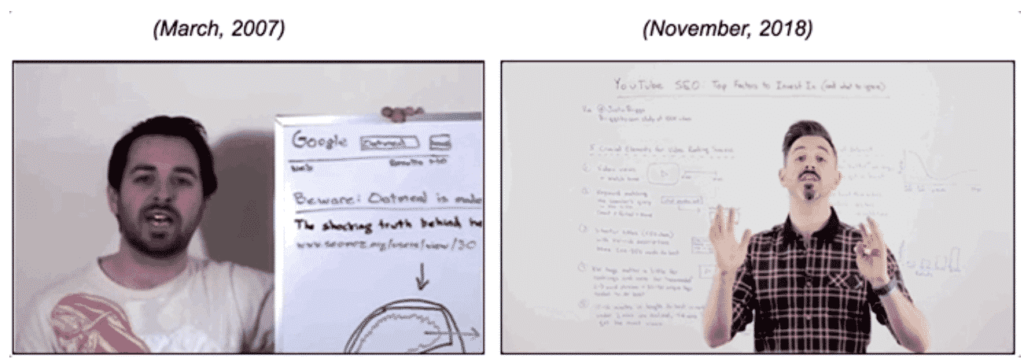
Whiteboard Friday still has a loyal audience — even though Rand has moved on from Moz.
It’s hosted by marketing pros like Will Critchlow of Distilled, Moz’s Brittany Muller, and Darren Shaw of Whitespark.
Moz’s commitment to high-quality content is simply exceptional. And that’s something many brands need to learn to drive any long-term growth through content marketing.
2. Databox’s sharp tying of content + product to scale
Databox sells a KPI tracking tool.
Besides ranking for several keywords related to their software, Databox’s SaaS content marketing strategy includes creating content that attracts buyers through every stage of their customer journey.
They publish top, middle, and bottom of the funnel content — attracting customers regardless of where they are in their journey.
But that’s not all, how they feature the capability of their software using iframes in their blog posts is even a more powerful ingredient in their SaaS content marketing strategy.
For example, in a post about Traffic Sources That Will Grow & Decline Next Year, they included an “editor’s note” that encourages readers to get a free web analytics template.
And that template is a major feature of Databox as a product.

This way, they’re subtly selling the benefits of their product. It’s smart. And it’s not pushy or salesy. It’s a simple editor’s note telling readers about a template that will help with the topic they’re reading.
Recommended content
3. Close.com’s strategic content upgrades
Close.com sells a sales automation tool.
Their blog generates ~277k visits a month (about 50% of their entire site traffic), and that number is close to 300k in some months, according to Similar Web.

They’ve optimized their posts to attract millions of search visitors, ranking for keywords like:
- sales training
- cold call
- sales plan
- sales strategy
- and many other keywords their target customers — salespeople — search for in the millions every month.
A smart bit of Close’s content marketing plan is content upgrades.
They use content upgrades on many (if not most) of their blog posts.
For example, their article about “31 best sales books” ranks #2 for “sales books” — a 14,000 search volume keyphrase.

In the post, Close.io listed 31 sales books for salespeople and included a content upgrade at the end of the post.
Readers interested in more sales books will opt in for the content upgrade and Close.io acquires them as subscribers or leads.
This way, they’re pouring hundreds or even thousands of leads and users into their funnel.
*Author’s note: Rank for high-converting keywords, increase your traffic (relevant) monthly visitors, and drive conversions (leads, sign-ups, etc). All done for you. See how we do it. (The link opens in a new tab).
4. UpLead’s brilliant case studies and resource posts
UpLead is a SaaS product that helps B2B salespeople find and connect with target buyers.
What better way to attract people who would have a need for their product than writing stories about how other businesses are acquiring leads and users?
UpLead creates in-depth case studies on how other companies are generating thousands of customers and users.

This way, they attract their target customers — folks who need help with lead generation or user acquisition.
UpLead also publishes long-form resource posts targeted at salespeople.
And they put a lot of energy into that — writing listicles that average 20 or more points per post.
Using resource posts like those, coupled with in-depth stories on user acquisition and growth marketing, UpLead’s traffic has been climbing for the past six months (as of the time of this writing):

For conversions, they use an exit intent pop up and add opt-in forms for downloadable PDFs at the top of their post pages.
UpLead’s founder Will Canyon shared with me that these two conversion optimization strategies have generated 20,000+ subscribers for their blog.
Here’s what their exit intent opt-in form looks like:

And here’s how they add downloadable PDF versions of blog posts at the top of their blog posts.

Will also mentioned that the PDF opt-in method converts the most.
In his own words: “I would say that [PDF opt-ins at the top of blog posts] made the biggest impact and I highly recommend it!”
5. HubSpot’s super smart lead generation strategy
As you probably know, HubSpot sells a robust inbound marketing tool, serving over 52,000 customers — whom they acquired through several marketing channels like certification programs or courses, free tools, and content.
But of all the useful instruments in HubSpot’s SaaS marketing strategy toolkit, content is MAJOR.
They use content to convert strangers into leads and buyers.
As of now, Hubspot has three blogs for four audiences — marketers, salespeople, and customer service teams — that altogether attract almost eleven million visitors to their site every month.

All these blogs make Hubspot.com a powerhouse of content that generates leads and users on autopilot.
For instance, a HubSpot senior marketing manager, Lindsay Kolowich, wrote an article on “15 of the Best ‘About Us’ & ‘About Me’ Pages and How to Make Your Own”, and it ranks #1 for about us page — an 8,100 volume keyphrase.
For conversions, they have strategic Calls to Action (CTAs) that persuade readers to sign up and become subscribers and leads.
The first one appears right under the author bio at the top:

They introduce the second opt-in CTA right after the fourth paragraph of the introduction:

And there’s the third CTA — just after the introduction:

Each subscriber they acquire enters a funnel that converts many of them into HubSpot users.
HubSpot is clearly not doing content marketing like many other SaaS brands.
They get it. They understand its value and are taking all the necessary steps to make it drive tangible bottom-line results:
- Quality content, check.
- On-page SEO, check.
- Off-page SEO, check.
- Link building, check.
- Strategic CTAs around content, check.
- Anything else you can think of that’s relevant, check.
But an obvious corner to their marketing strategy is the emphasis they place on content that provides value and earns customer attention.
In an interview at IMPACT, HubSpot founder Dharmesh Shah describes it like this: “The best way to win consumer attention is by creating a truly inbound experience that is less interruptive, more relevant, and more helpful than anything they’ve experienced before.”
6. Ahrefs’ focus on content quality over quantity
In the SEO world, there’s hardly anyone who doesn’t know Ahrefs.
Their tool does a lot of marketing for them, given its quality.
Everyone talks about it.

But much of the brand’s popularity today can also be attributed to their focus on content quality. Each of their posts gets at least 200 shares in a week and several comments as well.

You might argue that share and comment numbers are vanity metrics.
And you’d be right, they are.
But while they’re vanity metrics, they’re also an “attention metric” — because if readers are sharing your content and commenting on it, you have proof your content is attracting and holding their attention so much that they’re taking extra efforts to comment and share.
And in marketing, attention is usually the first thing you go after.
Without it, no one is buying your product.
After “attention” comes every marketing ROI you’re looking for.
Okay, back to that talk about how Ahrefs is getting buyer attention through content. They try to create the best content on every topic they publish.
And as of the time of this writing, they’re publishing one to two articles per week.
Their main distribution channel is SEO. And they have a pretty large fanbase on social and email, too.
7. Chanty’s grand exit-intent form on blog posts
Chanty is one of the most-mentioned companies in my survey about brands crushing SaaS content marketing.
They sell a Slack alternative product, an AI chat tool for teams.
Besides their amazing blog posts on productivity-related topics, they have a strategic opt-in form that appears just when you’re about to leave their blog posts.
But what’s super attractive about the form is how grand they make it.
It covers the entire screen and it’s super engaging.

And it’s super effective as well:
After reading a post about productivity on their blog, they present you with this elegant exit-intent form that promotes their tool — describing how it can help your team’s productivity by saving 30% of your time.
I asked Chanty’s CMO Olga Mykhoparkina to share some results they’ve been getting from this form so far, and she said:
“As I’m looking at our January (2019) analytics right now, exit popup is responsible for 56% of all product sign-ups in Chanty.”
Amazing.
She also shared how they’ve been getting compliments from new sign-ups about the popup. And someone got so impressed by the exit-intent popup that they started a Reddit thread about it:

To put it simply, Chanty excels at SaaS content marketing with an effective conversion optimization strategy that impacts their revenue.
Their results are impressive!
8. Groove’s unique storytelling strategy
Groove is a customer support software.
They have over 8,000 customers and 150,000+ blog subscribers.
I bet you’d agree those are big numbers in the SaaS world.
But Groove’s Rome wasn’t built in a day.
In the same way that many SaaS marketers struggle now, the company’s founder — Alex Turnbull — and his team kept failing at content marketing for two years.
Eventually, they decided to take their content efforts up a notch.
They started sharing stories about their journey to $100,000 in monthly revenue and got plenty of influencers (80 of them) to share each of the blog posts.
A year later, they clocked three years old and were at $5M/year thanks to their content.

A few reasons why their content marketing strategy worked:
- The angle of their story, journey to 100K in revenue, wasn’t common at the time.
- They were totally transparent, sharing every bit — good and bad — of their journey.
- They involved about 80 influencers and had them promote each blog post.
Now, you still may be wondering why a customer support software company reached $5M/year by publishing blog posts about their startup journey, rather than crowing about their terrific customer support.
Well, those stories — the ones that shared how Groove grew — attracted startup founders.
Those founders had customers and would need Groove’s customer support tool.
Thousands of them signed up for it.
In a podcast at SaaS Club, Groove marketer Andy Baldacci says it like this: “…the startup journey blog, that’s what people know us for. That’s why when we talk to a lot of customers, that’s how they hear about us.”
Basically, the “journey to 100k” stories generated awareness for Groove and ended up selling the product to thousands of buyers.
9. Kinsta’s in-depth how-to posts
Kinsta sells premium WordPress hosting.
And they’ve been super successful.
As of now, much of their traffic — according to SimilarWeb — comes from their blog posts:

They create really in-depth how-to posts on topics closely related to hosting.
And they’re ranking really well for many of them.
In fact, SEMrush reports that much of Kinsta’s traffic comes from the top keywords in its industry.
A big part of those keywords is “Google fonts” — a 1.5M search volume keyword.

Not too bad for a keyword that gets over 1M searches every month.
How they ranked it is similar to how the other brands listed above did it:
- Write in-depth posts
- Use several images and relevant alt texts for them per post
- Optimize each post with a focus keyword
Do these consistently and your traffic will improve.
10. Hotjar’s behind the scenes blog posts
Hotjar is a user experience software.
With over 300,000 customers from companies like Microsoft, Nintendo, and Intuit, their product is clearly doing an amazing job.
And that alone has helped promote their brand to millions around the world.
But their top-notch content marketing strategy does a lot of promotion for them as well.

Besides their podcasts and regular high-quality blog posts, they create unique behind-the-scenes stories about their failures and successes at Hotjar.
They make these posts grand and, consequently, they capture a lot of attention.
You’d see huge numbers in their headlines, so that encourages you to want to check the stories out even more.

This way, Hotjar attracts top of the funnel (TOFU) customers.
They make the posts super in-depth so readers get enough meat from the content.
And in-depth content is paying off really well for Hotjar; they have blog posts ranking for terms closely related to their product like:
- heatmap
- improve customer experience
- create user personas
- heatmap examples
These are keywords that are closely tied to the Hotjar software, and ranking for them drives relevant traffic for the SaaS unicorn.
11. Shopify’s smart SaaS marketing + control over target industry keywords
Shopify is a top SaaS brand and a leader in ecommerce.
As of now, they’re the sixth most popular business service site in the world — according to SimilarWeb:

Was it content marketing that helped them grow?
Not entirely.
But it was a huge contributor to their growth.
They identified their customers’ major pain points and created tons of content that addressed those problems.
This is why, right now, they’ve taken control of almost every ecommerce-related keyword.
Their target customers are ecommerce owners and marketers.
So they keep creating content that is bent on making them look awesome in the eyes of that audience.
And now, even with their current level of growth and prominence, Shopify hasn’t stopped churning out high-quality content.
They keep publishing blog posts, courses, video content, podcasts and resources.

It’s a brilliant SaaS content marketing strategy.
When ecommerce owners are looking for any question at all relating to their business, they know Shopify has content on it already.
And Shopify has a ton of content ranking for those questions.
In fact, they have a blog post that ranks #2 for “ecommerce website.” — a 27k search volume keyword.

The article is a list of 100+ ecommerce brands with the best website designs.
It’s top of the funnel content, but it creates massive brand awareness for Shopify.
And that’s just one of all their content, they have content that ranks for tons of other powerful keywords that generate millions of visitors monthly.
12. Intercom’s content promotion strategy through retargeting ads
Books, blogs, guides, and webinars form a major part of Intercom’s SaaS marketing plan.
The brand sells a customer messaging tool for businesses.
And they’ve been clearly awesome at that.
But like many other successful SaaS businesses, Intercom’s marketing strategy capitalizes a lot on content.
And what’s really impressive is how they promote their content.
Recently, they wrote a book and promoted it through retargeting ads.
That’s very strategic and smart.
It’s a way to ensure the book doesn’t just take up space on their site but actually attracts relevant traffic for their business.

This way, Intercom is not investing in content and merely hoping that it delivers value somehow.
They’re going all out, distributing the content where prospects will find it.
13. Woodpecker’s centre-aligned blog and smart CTA
Woodpecker sells an email outreach tool.
With over 2,500 B2B brands using the software, Woodpecker is making quite an impact in the sales and marketing space.
Every month, their blog registers over 60k visits.
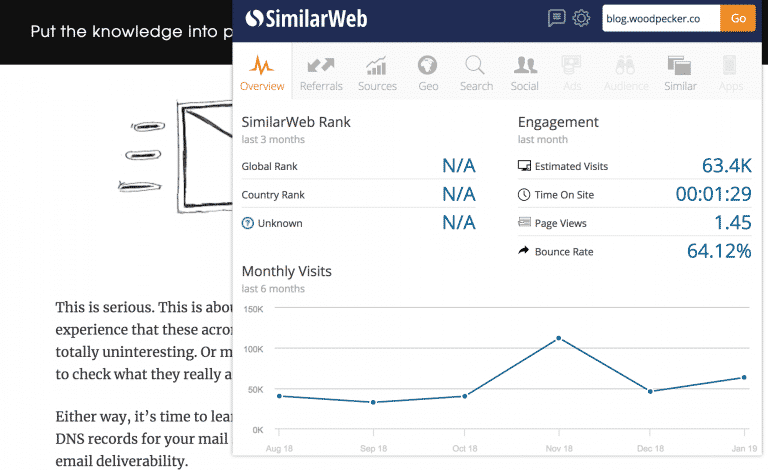
There are a lot of carefully designed parts to their blog, but one that really stands out is how each post is aligned to the centre.
It helps readers focus on the article and nothing else on the Woodpecker blog.
And then, as they keep scrolling down and reading a post, a big and targeted CTA shows up from below the article, once readers are about 50% into the post.
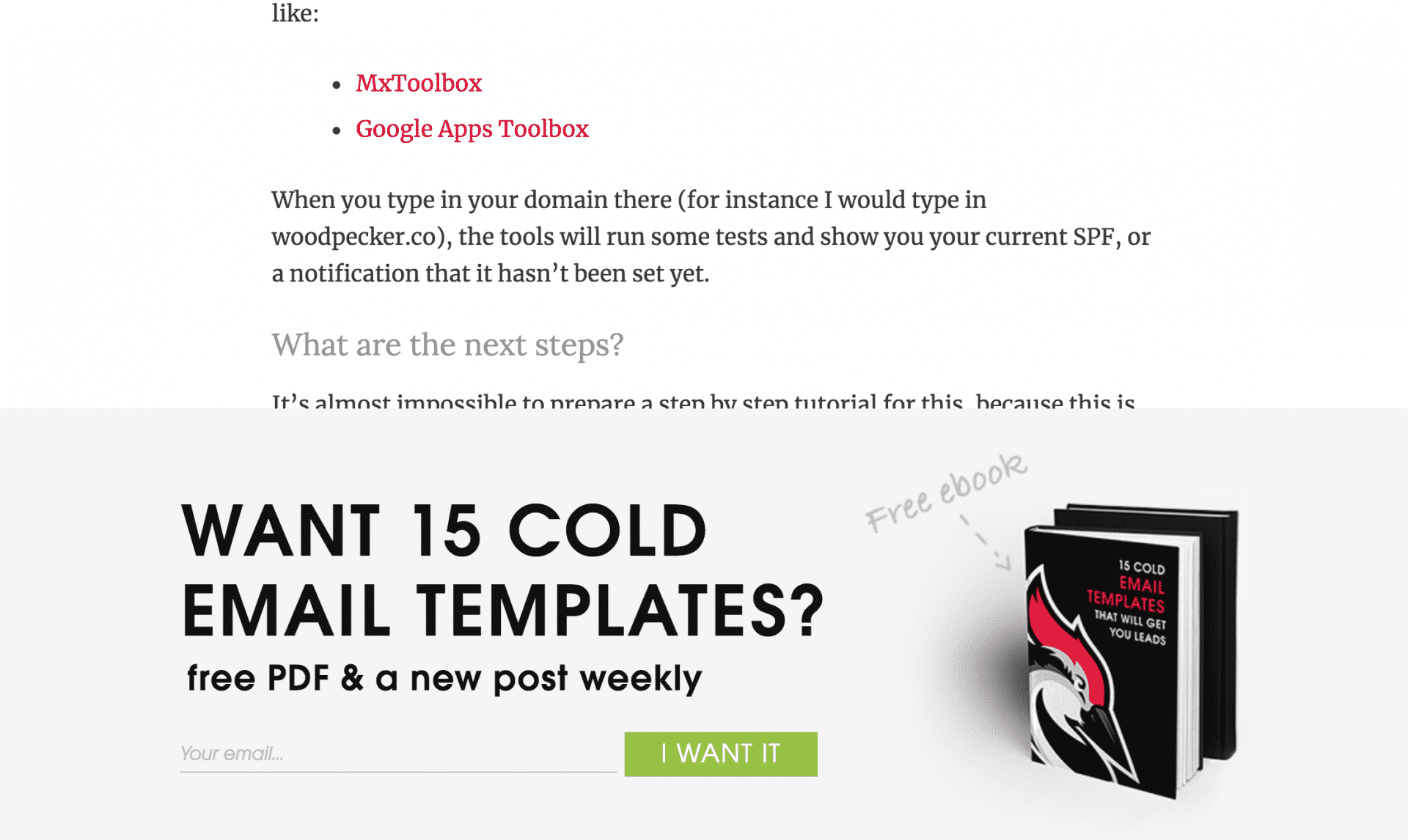
The CTA is well-designed and makes a relevant offer.
It’s a smart conversion optimization strategy designed to convert readers and take them to their next step in Woodpecker’s buying journey.
14. Sleeknote’s laser focus on audience-centric keywords
Sleeknote provides conversion optimization software for ecommerce businesses.
A huge part of the brand’s SaaS marketing strategy is its laser focus on creating content about topics that attract ecommerce business owners and marketers.
And they rank for many of those keywords, including:
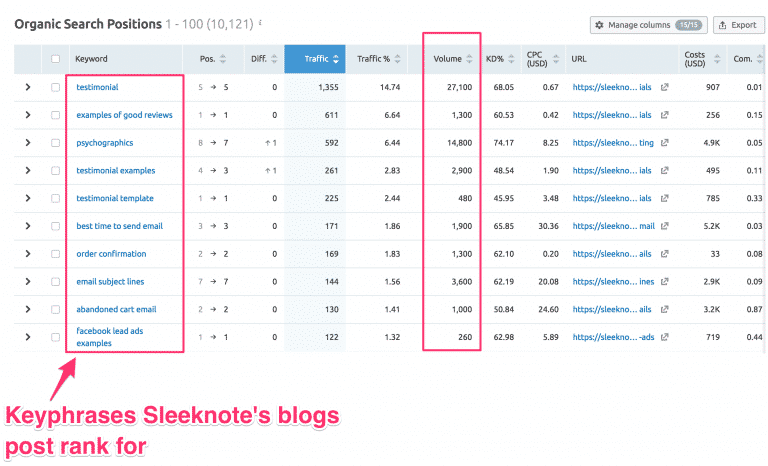
These topics are all centred on “conversions” — and that’s what Sleeknote helps their customers with.
This way, they’re successfully tying their product with the content they produce to drive highly relevant traffic and conversions for their business.
But how they’re ranking for these powerful keyphrases is what you want to know.
Let’s take one of their high-ranking posts — 7 Simple But Powerful Customer Testimonial Examples You Can Steal

The article ranks on Google’s page 1 for powerful keyword variations like:
- “testimonials” — 135,000 searches/mo
- “Customer testimonials” — 2,900 searches/mo
- “testimonial examples” — 12,000 searches/mo
- “testimonial templates” — 2,900 searches/mo
In total, minus keywords not accounted for here, this article pulls in thousands in traffic every month.
Now, how did they rank this post?
Four things:
- “Testimonials” was mentioned 27 times in the article
- “Testimonial examples” was mentioned
- 24 images
- A video
All of these contribute to why the post is ranking for such powerful keywords.
It may look stressful and time-consuming, but Sleeknote follows this SEO optimization strategy for all their posts and they get amazing results.
15. ClickFunnels’ elegant video case studies
ClickFunnels sells a marketing funnel software tool.
They have thousands of customers, and many of them get amazing results through ClickFunnels.
And that’s an opportunity the SaaS brand maximizes to the fullest.
They make lots of case study videos about their customers in every industry:
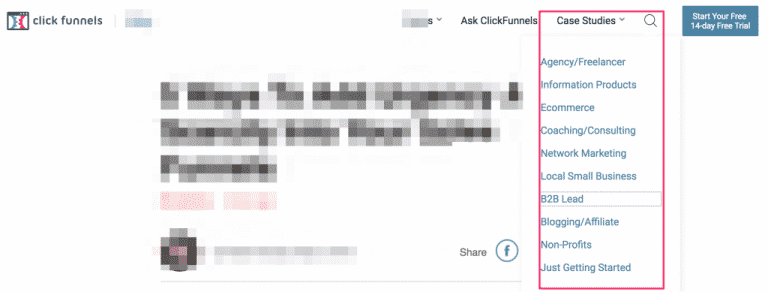
And they make those videos elegant enough that their target customers enjoy spending time watching — they pay attention and stay on the site.
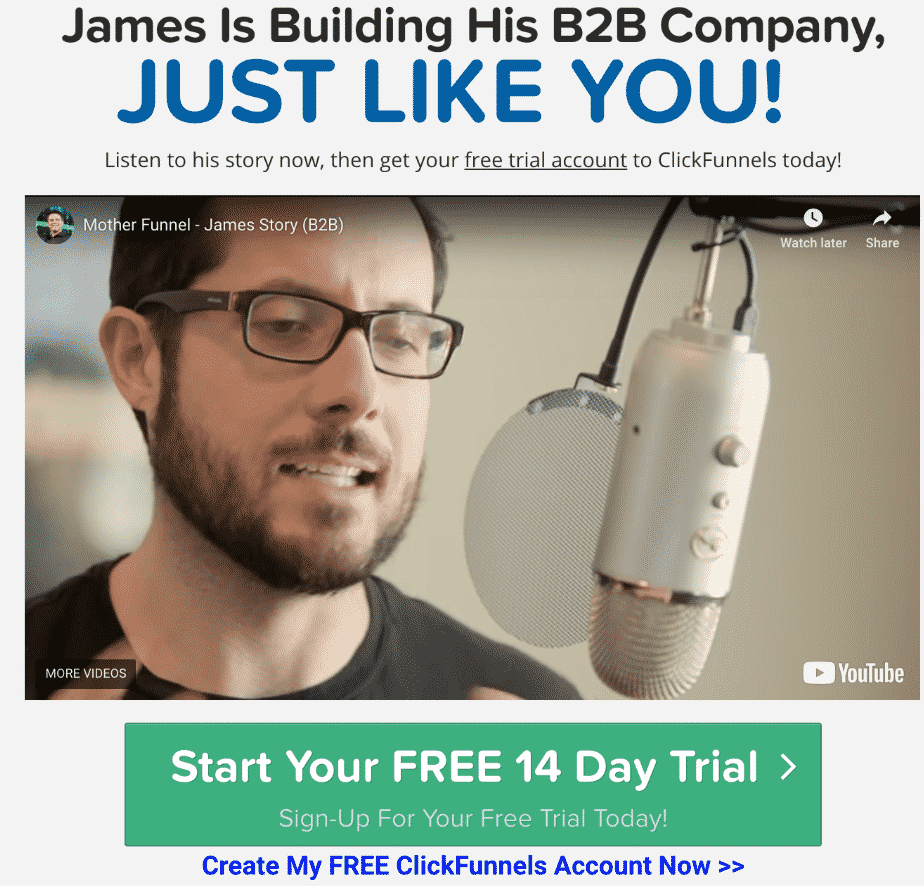
Then they put a 14-Day free trial CTA right under the videos.
Which is super smart.
This way, they’re generating users while or immediately after grabbing their attention with classic videos that prove their tool delivers on its promise.
16. Sumo’s big-number growth case studies
Sumo is a conversion optimization software provider.
When the company’s founder Noah Kagan was looking for content marketing advice, he found Brian Dean of Backlinko and read lots of his content.
Eventually, he got his content marketing teeth really sharpened and used that to grow Sumo.
“At Sumo, content marketing has been a killer tactic for us.” — says Noah.
They publish several categories of super high-quality content.
But one that significantly stands out from the rest is the Sumo Growth Studies category.

This category of Sumo content works so amazingly, they get comments like:



And rightly so.
People want to learn from stories, personal and case studies, more than tips and tricks that don’t contain real-life anecdotes.
17. CakeHR’s big free trial CTA on blog posts
As you’d notice from its name, CakeHR sells employee management software.
And they have a blog that drives 30,000+ monthly visitors.

That number may look small compared to the other brands above and below, but when it’s the right traffic, 30,000 visitors is a big deal.
And that’s what CakeHR is doing.
They’re targeting HR folks with in-depth content that’s relevant to them. And relevant content makes visitors stay on site long enough to convert.
Once readers (HR specialists) scroll about 60% into an article on CakeHR’s blog, they get a CTA popup about an “easy to use HR software.”
It’s a smart tactic — because if your readers are 60% into reading an article, then they’re pretty hooked. The chances they’ll get turned off by an HR-related pop up is pretty low.
In the example above, for instance, readers will only see the CTA when they’ve read 40 out of the 50 tips on team building games.
This is smart because it helps CakeHR show their CTA to people whose reading behaviour show strong interest in the problem their product solves.
18. CoSchedule’s 3-point principle for 1M+ monthly pageviews
CoSchedule sells marketing project management software.
And the business grew almost entirely through content marketing.
CoSchedule founder Garrett Moon says:
“In fact, killer content is so central to our growth and marketing that we boiled down our strategy to three principles:
- Pinpoint what positively impacts a huge number of people in your audience
- Find those topics by analyzing your competitors and strategizing a new angle
- In your content, unite your audience’s interests with your company’s value
“All of that helped us grow from absolutely zero traffic to 1 million plus pageviews per month (and roughly 400,000 unique visitors).”


